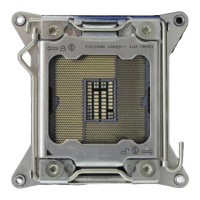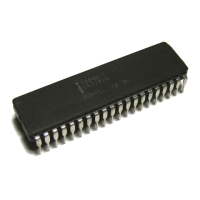Reference Number: 327043-001 109
Intel® Xeon® Processor E5-2600 Product Family Uncore Performance Monitoring
TxL_FLITS_G2
• Title: Flits Transferred - Group 2
• Category: FLITS_TX Events
• Event Code: 0x01
• Extra Select Bit: Y
• Max. Inc/Cyc: 2, Register Restrictions: 0-3
• Definition: Counts the number of flits trasmitted across the Intel® QPI Link. This is one of three
"groups" that allow us to track flits. It includes filters for NDR, NCB, and NCS message classes.
Each "flit" is made up of 80 bits of information (in addition to some ECC data). In full-width (L0)
mode, flits are made up of four "fits", each of which contains 20 bits of data (along with some addi-
tional ECC data). In half-width (L0p) mode, the fits are only 10 bits, and therefore it takes twice as
many fits to transmit a flit. When one talks about Intel® QPI "speed" (for example, 8.0 GT/s), the
"transfers" here refer to "fits". Therefore, in L0, the system will transfer 1 "flit" at the rate of 1/4th
the Intel® QPI speed. One can calculate the bandwidth of the link by taking: flits*80b/time. Note
that this is not the same as "data" bandwidth. For example, when we are transfering a 64B cache-
line across Intel® QPI, we will break it into 9 flits -- 1 with header information and 8 with 64 bits of
actual "data" and an additional 16 bits of other information. To calculate "data" bandwidth, one
should therefore do: data flits * 8B / time.
Table 2-102. Unit Masks for TxL_FLITS_G1
Extension
umask
[15:8]
Description
SNP bxxxxxxx1 SNP Flits:
Counts the number of snoop request flits transmitted over Intel®
QPI. These requests are contained in the snoop channel. This does
not include snoop responses, which are transmitted on the home
channel.
HOM_REQ bxxxxxx1x HOM Request Flits:
Counts the number of data request transmitted over Intel® QPI on
the home channel. This basically counts the number of remote
memory requests transmitted over Intel® QPI. In conjunction with
the local read count in the Home Agent, one can calculate the
number of LLC Misses.
HOM_NONREQ bxxxxx1xx HOM Non-Request Flits:
Counts the number of non-request flits transmitted over Intel® QPI
on the home channel. These are most commonly snoop responses,
and this event can be used as a proxy for that.
HOM b00000110 HOM Flits:
Counts the number of flits transmitted over Intel® QPI on the home
channel.
DRS_DATA bxxxx1xxx DRS Data Flits:
Counts the total number of data flits transmitted over Intel® QPI on
the DRS (Data Response) channel. DRS flits are used to transmit
data with coherency. This does not count data flits transmitted over
the NCB channel which transmits non-coherent data. This includes
only the data flits (not the header).
DRS_NONDATA bxxx1xxxx DRS Header Flits:
Counts the total number of protocol flits transmitted over Intel® QPI
on the DRS (Data Response) channel. DRS flits are used to transmit
data with coherency. This does not count data flits transmitted over
the NCB channel which transmits non-coherent data. This includes
only the header flits (not the data). This includes extended headers.
DRS b00011000 DRS Flits (both Header and Data):
Counts the total number of flits transmitted over Intel® QPI on the
DRS (Data Response) channel. DRS flits are used to transmit data
with coherency.

